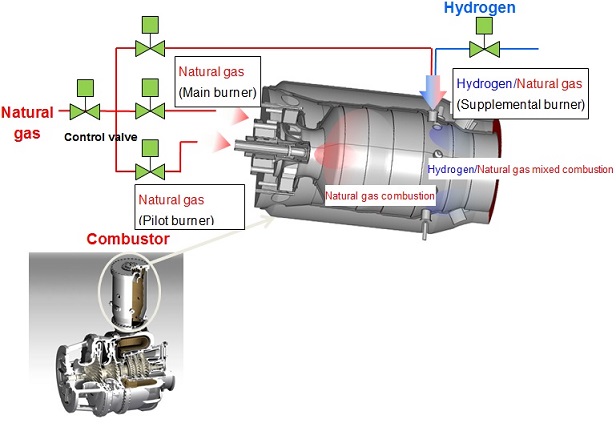Kawasaki to Begin Demonstration Test of Low-NOx Gas Turbine Using Mixed Hydrogen Combustion System
May 26, 2015
Tokyo, May 26, 2015 — Kawasaki Heavy Industries, Ltd. announced today that it will begin a demonstration test of a low-NOx gas turbine employing a mixed combustion of hydrogen and natural gas at its Akashi Works.
The Akashi Works will use one of its three gas turbines used for in-house power generation to conduct a demonstration test of the mixed hydrogen combustion system. The gas turbine to be used in the testing is Kawasaki's M1A-17D with a rated electrical output of 1,700 kW. Boasting the world's highest level electrical efficiency in its class, the gas turbine employs a dry low emissions (DLE) combustor featuring Kawasaki's proprietary supplemental firing combustion system.*
The DLE combustor is equipped with three types of burners. While ignition is achieved with the pilot burner, higher load operation is handled with the main and supplemental burners. This operation strategy helps keep combustion temperature low with minimal NOx emissions—NOx emissions are lower than levels achieved with water or steam injection techniques. Moreover, its simple equipment and system configurations make it economically superior.
Kawasaki has added a hydrogen fuel system to the supplemental burner so the gas turbine can be powered by both hydrogen and natural gases. Hydrogen gas usage can be adjusted between 0% and approximately 50% per volume of fuel (0% and approximately 25% in quantity of heat), meaning that the gas turbine can also be powered solely by natural gas. The NOx emissions level will be kept to 25 ppm or less at 15% O2 during the mixed combustion of hydrogen and natural gas mixtures.
Gas turbines employing mixed combustion of hydrogen can reduce natural gas usage as well as CO2 emissions by making effective use of wasted hydrogen gas produced as a by-product in oil refineries, etc. The demonstration test will examine the operational stability of the mixed hydrogen combustion system, including NOx emissions, combustion temperatures, and fuel supply systems, to determine how effective the use of hydrogen is.
Kawasaki is working to develop and commercialize infrastructure technologies with an eye to building a complete supply chain that includes everything from the production to transportation, storage, and use of hydrogen. It sees this gas turbine employing a mixed hydrogen combustion system as the gateway that will lead to widespread use of hydrogen energy. The innovative solution is just one more example of how Kawasaki is working as one for the good of the planet.
*A system that injects air and fuel from a supplemental burner in addition to fuels blown in through pilot and main burners to maintain stable combustion with minimal NOx emissions.


Contact
If you need more information about our business,
please feel free to contact us.





